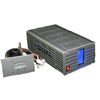- Qualcomm Launches Snapdragon 4 Gen 2 Mobile Platform
- AMD Launches Ryzen PRO 7000 Series Mobile & Desktop Platform
- Intel Launches Sleek Single-Slot Arc Pro A60 Workstation Graphics Card
- NVIDIA Announces Latest Ada Lovelace Additions: GeForce RTX 4060 Ti & RTX 4060
- Maxon Redshift With AMD Radeon GPU Rendering Support Now Available
XG Magnum 600W External PSU

Power supplies are getting bigger and more powerful each year, pumping more and more heat into PC cases. Today we take a look at an external solution that promises to lower in case temps and help your PC keep it’s cool.
Page 2 – Internals & Externals
The cables supplied with the unit are a two part setup. There are cables that go in the case, they’re attached to a plate that mounts to the rear of the case in place of your standard PSU, from there there are three shielded UV reactive cables that connect the PSU to the actual PC. The cables inside the case are generous and have no trouble reaching anywhere inside my Tt Armor which is by no means a small case. The list of connectors inside the case are 6-4pin Molex connectors, 2-5 connector SATA connectors, 2-4pin Floppy connectors, 2-6pin PCI-e connectors, 1-2x2pin ATX 12V connector and 1-2x4pin E-ATX connector. The main ATX connector is of the 20+4pin variety which allows for use with older systems.
The three cables running from the PSU to the back plate are about 15″ long and are terminated with ATX style plugs that are specific to the EAZ and Magnum EX, you can’t use this PSU with the cables off your modular PSU so don’t bother trying. I’ve seen other people commenting on the stiffness of these cables and I have to agree, they’re very stiff. In fact, they’re so stiff that they have no problem dragging the ten pound PSU around on the case if I manage to get all four rubberized feet off the top of the case.
Taking a look at the PSU we notice that it has a quasi-industrial look, in a refined polished sort of way. The casing is made of ventilated anodized aluminum that is finished with a pleasing champagne color. The front (Or rear as XG calls it) features the LCD display along with the power on/off button for the PSU. Having the button at the front of the power supply is a blessing and a curse. It’s a blessing as it does away with fumbling around at the rear of the PC to turn the power supply off if you’re working on the system (Repeat after me: “I will turn off the power supply before adding or removing any cards, including ram, from the motherboard”) but it’s a curse if you have inquisitive little ones that are able to come in contact with the pretty red button on the box on top of daddy’s (Or mommy’s) PC. I don’t know what it is about bright red buttons and kids but they are *not* a match made in heaven.
I’m sure the sharp eyed readers noticed that the top case screws were missing in front and back on the PSU. Yes, indeed, I am tearing this one apart as well. Due to the design of the massive heat sinks on the EX it’s nearly impossible to see the internal layout of the power supply but from what we can see we’ll notice that it is absolutely crammed with components. As we can see the EX isn’t fan less as is stated on XG’s site, instead it has an internally mounted 80mm fan that draws air from the front of the PSU and blows it over the huge copper heat sinks. Sadly, the one drawback to this design is that allows heated air to re-circulate within the PSU case.
Looking on the other side of the XG we see that the PSU is divided in half, the left side (Looking at the front of PSU) is the Active PFC circuitry and the right side is the power output section. The APFC section features a single 470mFD RubyCON power conditioning cap and a huge toroid transformer. Looking to the right of my thumb (Next to the ferrite choke on the red and black power wires) is the thickest small diameter toroid I’ve ever seen. I made certain it’s not two transformers stacked side by side because I was so surprised. I guess that when you only have a fixed vertical limit you’ve got to expand horizontally.
Installed in the case it looks strangely empty, there’s a big gaping void where the PSU would normally go. So strange to not see a big block of metal up there next to the HDD cage.
|
|
Support our efforts! With ad revenue at an all-time low for written websites, we're relying more than ever on reader support to help us continue putting so much effort into this type of content. You can support us by becoming a Patron, or by using our Amazon shopping affiliate links listed through our articles. Thanks for your support!













